Contents
of the Summer 2011 Northants News
|
The
sex life of Dorstenia lavrani
Tina
Wardlaugh
|
You can click on Tina's images
for a better view.
|
When I saw the first
pictures of the newly described Dorstenia
lavrani
in the American Journal (CSJ Vol. 80, No.2, 2008), it was lust at first sight
and this became the plant I had to have.
D.
lavrani
is apparently unique in the genus as each plant produces only male or
female flowers (so it is dioecious), so to produce seed, plants of both sex are
needed. This contrasts with other dorstenias
that have flowers of both sexes on the same plant (and
are therefore monoecious) so that seeds are freely produced from just a single
plant. It’s quite a recent addition to the genus since it was only discovered
by John
Lavranos in 1973 and named in his honour by Tom McCoy and Mike Massara in 2008.
In habitat it grows in shady moss filled cracks in a limestone gorge
- this
gives a clue to the growing conditions needed in cultivation.
Then the challenging task of trying to obtain
some of these lovely plants began. In addition to its ‘proper name’, it is
also listed under various names such as Dorstenia
Taba’a Gorge, Dorstenia species Mait Plateau and Dorstenia
L&H
10341; these all relate to its habitat localities and collections from the
Republic of Somaliland. You
do need to ‘see
before you buy’
or check on the origin of the plants if you can, as there seem to be some
hybrids being miss-sold as D.
lavrani.
My first plant was a
purchase from Arid Lands in Tucson, Arizona, USA. This nursery does not sell
outside of America, but my purchase was assisted by a friend. The plant arrived
in July 2008 and soon started growing.
|
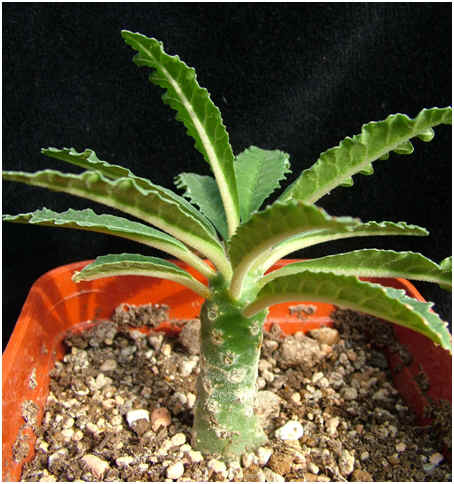
|
|
Above:
A rooted cutting of Dorstenia
lavrani.
Below:
A group of D.
lavrani, two
females at the rear and a male at the front. |
|
It is a very knobbly
plant, which produces branches all over the main stem so there have been some
doubts about its parentage. When the inflorescences developed it was a female
plant.
Then I was lucky to buy an unrooted cutting from
Bob Potter in August 2009. It did
not appear to grow for about 6 months, but when I compared photos taken of it
during this time I could see that the base had in fact doubled in girth even
though the top had hardly grown, establishing roots perhaps. It then started to
produce small offsets at the base. This plant flowered under lights during the
winter and
turned out to be another female.
So I still needed a
male and the hunt continued!
By 2010 I was getting slightly disappointed,
(obsessed maybe), as this isn’t a common plant and most suppliers are in the
USA. Luckily my friend managed to contact the nursery Out of Africa, Naples,
Florida and purchased a known male plant for me. The nursery is owned by Mike
and Maureen Massara and since Mike was co-author of the original article on the
species this source ought to be authentic.
This plant arrived in September 2010. It wasn’t cheap but as the deal involved
swapping some plants the transaction was quite painless!
|
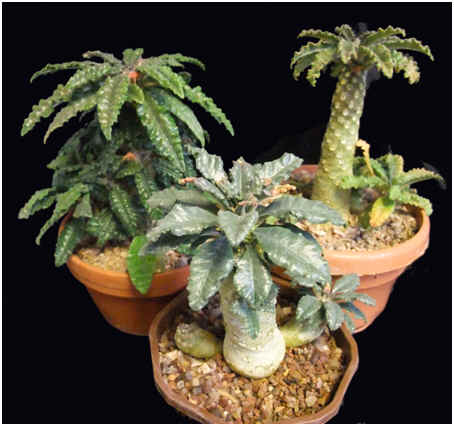
|
|
|
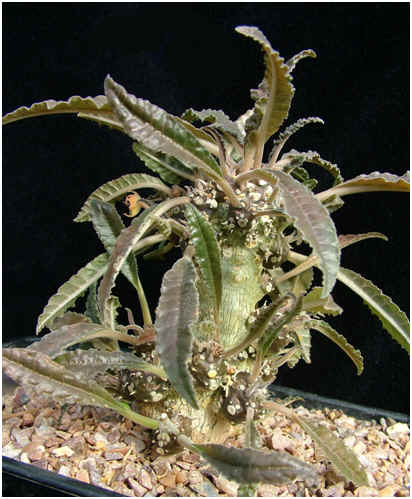
|
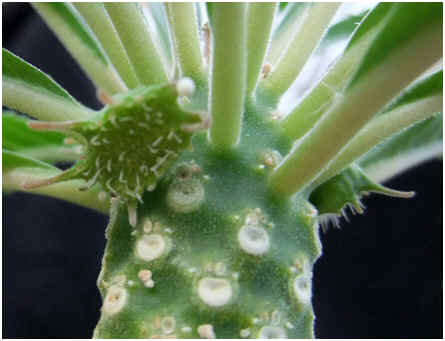
|
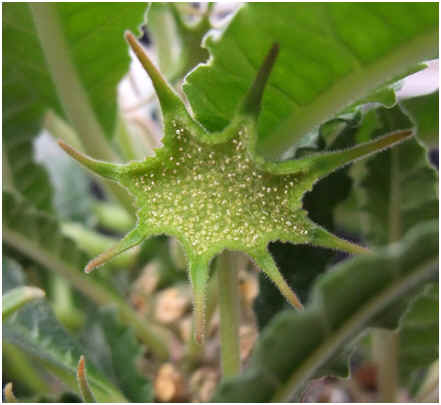
|
|
The
original 'Arid Lands' plant of suspect parentage. Note unusual excessive
branching. |
Female
flowers visible as fine white filaments (the stigmas).
|
Lots
of small male flowers in the inflorescence (hypanthodium). |
Cultivation
These plants do not seem very demanding. All
three plants were at least 3" tall when purchased so it’s perhaps the
seedling stage at which they are more difficult to re-establish. In the
greenhouse I grow them at a minimum of 12oC
on a bed of sand with under soil warming cables, out of direct sun in a slightly
shaded corner. The soil mix is 50:50 John Innes No. 2 and Tesco Premium cat
litter to make it free draining. I allow the pots to totally dry out before the
next watering, judged by weather conditions and also the cat litter is a useful
marker as it lightens as it dries out. Having the pots on sand does mean they
have nice moist roots without being wet. The unrooted cutting from Bob Potter
was dipped in hormone rooting powder and left for about a week, then placed in
damp Tesco cat litter at 25oC
for about 2 months until well rooted. For the winter they are pampered and come
to work where they live in a hot room, under lights at 25oC
daytime temperature and 18oC
at night with a 12 hour light-dark cycle. The humidity is set at 60% day and 75%
night; this is mainly to establish them as they are young plants.
All three plants are
slightly different looking as can be seen in the photos, the new male plant has
broader leaves which are a silvery, matt colour but it could be because of its
previous growing environment.
Plans
for the future
Dorstenias seem to
need a winter rest to promote flowering, so once my plants are larger I will let
them rest over the winter. In the summer I intend to do a complete repot of all
three plants so I have them all growing in exactly the same pots and soil mix,
so that any variations with the plant, leaf colour and shape will be genetic and
not due to cultivation differences.
I will let them grow unhindered in 2011 and then
in the summer of 2012 I intend to take cuttings so I have ‘back-ups’,
especially since the males are difficult to obtain so these will make good swaps
especially because I need another plant of Dorstenia
gypsophila.
Finally many thanks to Colin for all his help and
encouragement.
Tina
Ed:
Now here is a story that has
everything; passion, lust, uncertain parentage and maybe the future patter of
little Dorstenia feet. And I just love the name of that Nursery - Out of Africa,
Naples, Florida.
Thanks Tina!
Glossary
Dorstenia:
Genus of the Moraceae (Fig) Family with about 105 genera. Most cultivated
species come from tropical Africa, Socotra and Madagascar. Dorstenia is named in
honour of the German physician and botanist Theodor Dorsten (1492 - 1552)
Monoecious:
bearing separate male and female flowers on the same plant.
Dioecious:
bearing either male or female flowers on separate plants





